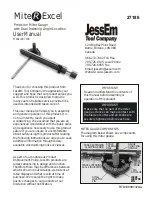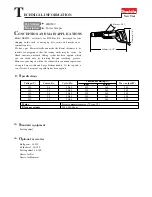
5
. The fence stop should look like this when
properly mounted on the main fence. (Fig. 5).
FIG. 5
SETTING THE SCALES ON THE FENCE
6. P
lace the miter gauge in the miter slot in
your table saw with the saw turned off.
Loosen the two brass fence clamping knobs
(shown in fig. 2) and slide to adjust the miter
fence so it is clearing the saw blade teeth by
at least 1/16 of an inch. Re-tighten the
fence clamping knobs. Then position the
fence flip stop so it is set 2 inches in from
the cutting edge of the saw blade. Tighten
the flip stop in position.
FIG. 7
FIG. 6
8. Loosen the ¼” socket head screw that
attaches to the slide bar on the fence
extension block (Fig. 8).
9. Loosen the fence extension locking knob.
Adjust the fence extension bar so the right
side of the fence extension scale indicator
lines up with the 26 inch mark on the fence
scale. Re-tighten the fence extension locking
knob (Fig. 9).
7. Loosen the fence scale locking dial (Fig. 7)
and adjust the sliding scale so the left edge of
the indicator lines up with the 2 inch mark on
the scale (Fig. 6). Then re-tighten the fence
scale locking dial.
FIG. 8
10. Slide the fence extension block all the way
in toward the main fence so it is tight against
the main fence (Fig. 10). Re-tighten the ¼”
socket head screw as shown in fig. 8. Slide the
fence stop onto the fence extension (Fig. 10)
and with a tape measure or steel rule set the
fence stop 26 inches from the cutting edge of
the blade and lock it in this position. Then
loosen the scale locking knob on the fence
extension and adjust the short scale so the left
side of the scale indicator lines up with the 26
inch line marked “STOP POSITION” (Fig. 10).
The scale for the fence extension is now set.
SET STOP 2” FROM
CUTTING EDGE OF BLADE
POSITION FENCE
AT LEAST
1/16” FROM
SAW BLADE
2”
SA
W
BLADE
LOOSEN FENCE
EXTENSION
LOCKING KNOB
FIG. 9
SLIDE FENCE EXTENSION
SCALE INDICATOR TO (26”)
FIG. 10
SCALE
LOCKING KNOB
SET STOP 26” FROM BLADE























